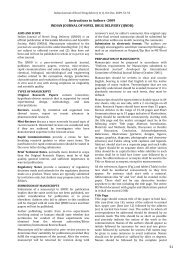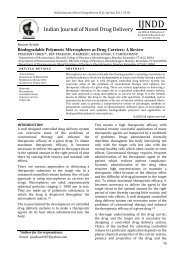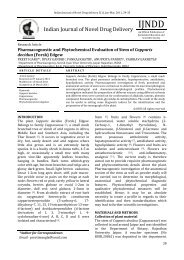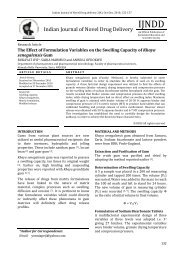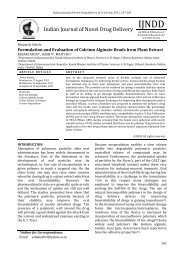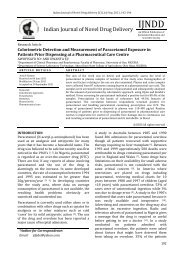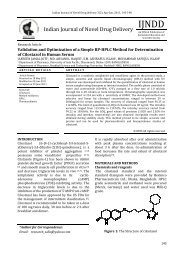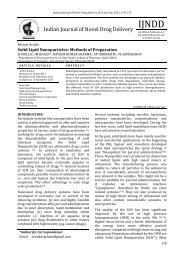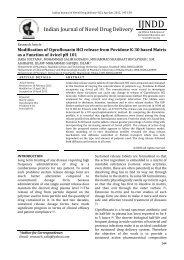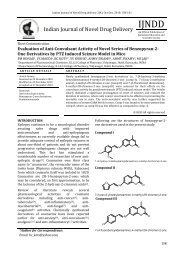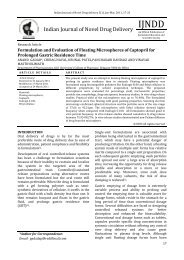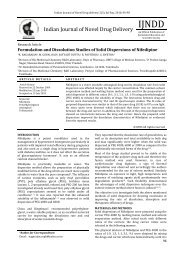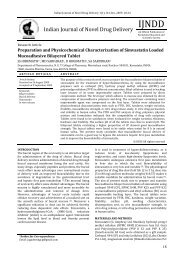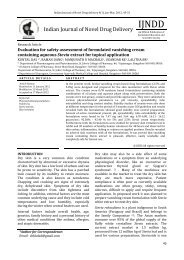Alkaloids from Zanthoxylum alatum stem bark with anti inflammatory ...
Alkaloids from Zanthoxylum alatum stem bark with anti inflammatory ...
Alkaloids from Zanthoxylum alatum stem bark with anti inflammatory ...
Create successful ePaper yourself
Turn your PDF publications into a flip-book with our unique Google optimized e-Paper software.
Indian Journal of Novel Drug delivery 4(2), Apr-Jun, 2012, 139-144<br />
Indian Journal of Novel Drug Delivery<br />
IJNDD<br />
An Official Publication of<br />
Karnataka Education and<br />
Scientific Society<br />
Research Article<br />
<strong>Alkaloids</strong> <strong>from</strong> <strong>Zanthoxylum</strong> <strong>alatum</strong> <strong>stem</strong> <strong>bark</strong> <strong>with</strong> <strong>anti</strong> <strong>inflammatory</strong><br />
potential in rats against acute and chronic inflammation in rats<br />
MINKY MUKHIJA 1 , ROHIT GOYAL 2 , AJUDHIA N. KALIA 3<br />
1 Department of Pharmacognosy, ISF College of Pharmacy, Moga 142001, Punjab, India.<br />
2 Department of Pharmacology, ISF College of Pharmacy, Moga 142001, Punjab, India.<br />
3 Department of Pharmacognosy, ISF College of Pharmacy, Moga 142001, Punjab, India.<br />
A R T I C L E D E T A I L S<br />
Article history:<br />
Received on 07 April 2012<br />
Modified on 23 May 2012<br />
Accepted on 28 May 2012<br />
Keywords:<br />
<strong>Zanthoxylum</strong> <strong>alatum</strong>,<br />
Rutaceae,<br />
Inflammation,<br />
<strong>Alkaloids</strong>,<br />
Flavonoids<br />
A B S T R A C T<br />
The study was designed to investigate <strong>anti</strong>-<strong>inflammatory</strong> active fraction(s) <strong>from</strong><br />
the aqueous extract of <strong>Zanthoxylum</strong> <strong>alatum</strong> <strong>stem</strong> <strong>bark</strong> in acute and chronic models<br />
of inflammation. Wistar rats of either sex were employed. Acute inflammation was<br />
induced by subplantar administration of carrageenan (1 %) in rat hind paw.<br />
Chronic inflammation was induced by interscapular implantation of a sterile cotton<br />
pellet (50 mg). Alkaloid fraction (100 mg/kg b.w) was found to be more effective in<br />
comparision to flavonoid (100 mg/kg) in carrageenan induced inflammation<br />
model. Hence was selected for further detailed study. Pretreatment <strong>with</strong> alkaloid<br />
fraction (100, 150 mg/kg) have shown significant (p < 0.05) check on carrageenan<br />
induced paw edema and significantly (p < 0.05) decreased granuloma tissue<br />
formation, as compared to control. The alkaloid constituents are more potent in<br />
prevention of acute and chronic inflammation. Hence, the present study has<br />
concluded that the alkaloids fraction is responsible for its <strong>anti</strong> <strong>inflammatory</strong> claim.<br />
© KESS All rights reserved<br />
INTRODUCTION<br />
Inflammation is defined as the local response of<br />
living mammalian tissues to any agent. It is a<br />
body defense reaction in order to eliminate or<br />
limit the spread of injurious agent, pathogens<br />
and noxious substances such as chemical or<br />
physical injury followed by removal of necrosed<br />
cells and tissues [1] . Inflammation is characterized<br />
by immune cell invasion, local release of<br />
cytokines and chemokines and sometimes<br />
accompanied by functional or structural damage<br />
of the invaded tissue [2] . The classic signs of<br />
inflammation are local redness, swelling, heat,<br />
pain and loss of function [3] .<br />
<strong>Zanthoxylum</strong> <strong>alatum</strong> (ZA) also known as<br />
<strong>Zanthoxylum</strong> armatum belongs to family<br />
Rutaceae is a perennial shrub or a small tree<br />
height upto 6 m <strong>with</strong> dense glabrous foliage and<br />
straight prickles on <strong>stem</strong>. It is distributed in<br />
Himalayas <strong>from</strong> Kashmir to Bhutan upto 2100 m<br />
and in Khasia hills upto 1350 m.<br />
*Author for Correspondence:<br />
Email: ankalia_47@rediffmail.com<br />
The <strong>bark</strong> contains berberine, asarinin, fargesin,<br />
dictamine, ɣ-fagarine, 8-hydroxydictamine,<br />
armatamine, epieudesmin, eudesmin, (-)-<br />
planinin, (+)-sesamin, (-)-sesamin, pluviatide, β-<br />
sitosterol, β-D-glucoside, α and β amyrin, β-<br />
amyrone, lupeol and vanillic acid [4] . The plant is<br />
extensively used in indigenous sy<strong>stem</strong> of<br />
medicine as a carminative, stomachic and<br />
anthelmintic [5] , in fever, dyspepsia and cholera [6] .<br />
Traditionally, the plant is used for abdominal<br />
colic, asthma, cancer, diabetes, cough, diarrhea,<br />
dysuria, fever, headache, hapatosis, microbial<br />
infections, toothache and worms, and useful in<br />
improving blood circulation to affected parts. It<br />
is also used as cardioprotective, analgesic, <strong>anti</strong><strong>inflammatory</strong>,<br />
pesticide, stomachic and tonic [7,8] .<br />
Pharmacological activities so far are <strong>anti</strong><strong>inflammatory</strong><br />
[9] , <strong>anti</strong>oxidant [10] , hepatoprotective<br />
[11] and larvicidal activities [12] . Since, the plant has<br />
been used traditionally for various <strong>inflammatory</strong><br />
disorders and the aqueous extract of ZA has been<br />
already shown to have <strong>anti</strong> <strong>inflammatory</strong><br />
activity [13] and aqueous extract has shown the<br />
presence of alkaloid and flavonoid in it when<br />
phytochemical screening was done. Therefore,<br />
<strong>with</strong> this background, the present study was<br />
designed to investigate the <strong>anti</strong> <strong>inflammatory</strong><br />
139
Ajudhia N. Kalia et al / Indian Journal of Novel Drug Delivery 4(2), Apr-Jun, 2012, 139-144<br />
active fraction (alkaloids or flavonoids) <strong>from</strong> the<br />
<strong>stem</strong> <strong>bark</strong> of ZA using acute and chronic models<br />
of inflammation in rat.<br />
MATERIALS AND METHODS<br />
Plant material<br />
The <strong>stem</strong> <strong>bark</strong> of ZA was collected <strong>from</strong> the local<br />
areas of Tehri (Garwal), Uttrakhand, India and<br />
got authentified <strong>from</strong> NISCAIR, New Delhi (Ref.<br />
NISCAIR/RHMD /Consult / 2009-10 / 1324 /<br />
127).<br />
Preparation of extract<br />
Aqueous extract of shade dried defatted <strong>stem</strong><br />
<strong>bark</strong> (1.5 Kg) was prepared by Triple<br />
maceration. The extract was concentrated in<br />
vacuo.<br />
Phytochemical screening<br />
The aqueous extract was screened<br />
phytochemically for the presence of<br />
carbohydrates, glycosides, phenolic compounds,<br />
alkaloids, flavonoids, saponins, steroids and<br />
terpenoids [14] .<br />
Separation of alkaloids and flavonoids<br />
fraction<br />
<strong>Alkaloids</strong> and flavonoids fractions were<br />
separated <strong>from</strong> the aqueous extract. [15],[16] The<br />
confirmation of alkaloids fraction was done using<br />
chemical tests like Mayer’s (Potassium Mercuric<br />
Iodide), Wagner’s (Iodine in Potassium Iodide),<br />
Dragendorff’s (solution of Potassium Bismuth<br />
Iodide), Hager’s (saturated picric acid solution)<br />
reagent test [14] . Flavonoids fraction was<br />
confirmed using Shinoda’s test, alkaline Reagent<br />
test and lead acetate test [14,17] .<br />
Experimental Animals<br />
Wistar albino rats of either sex weighing 180-<br />
220 g were procured <strong>from</strong> CPCSEA approved<br />
breeder (IIIM, Jammu). The animals were kept in<br />
polypropylene cages (3 rats in each cage) and<br />
maintained at temperature 25±2˚C, 55-65 %<br />
relative humidity and 12-12 h light and dark<br />
cycle in animal house of ISF College of Pharmacy,<br />
Moga. The rats were fed at commercially<br />
available chow diet procured <strong>from</strong> Aashirwad<br />
Industries Ltd., Ropar, Punjab, and water ad<br />
libitum. The experimental protocol was approved<br />
by Institutional Animal Ethical Committee (IAEC)<br />
(Reg. No. 816/04/C/ CPCSEA).<br />
Drugs and Chemicals/Equipments<br />
Carrageenan and diclofenac sodium were<br />
procured <strong>from</strong> Sigma Chemical Co., St. Louis, MO,<br />
USA and Novartis, India respectively. All other<br />
chemicals and reagents were of analytical grade.<br />
Plethysmograph was used to estimate paw<br />
volume. Test drugs (alkaloid and flavonoid<br />
fractions), reference standard (diclofenac<br />
sodium) were suspended in vehicle 1% CMC and<br />
administered orally.<br />
Acute <strong>anti</strong> <strong>inflammatory</strong> study<br />
Carrageenan induced rat paw edema<br />
The acute <strong>anti</strong>-<strong>inflammatory</strong> effect was<br />
evaluated by the carrageenan-induced paw<br />
edema method. Acute edema was induced by<br />
subplantar administration of 0.1 ml of<br />
carrageenan (1% w/v) in rats. The test drugs<br />
were administrated orally 1 h before injection of<br />
carrageenan. Paw volume was measured prior to<br />
injection of carrageenan (0 h) and then at<br />
predetermined intervals <strong>from</strong> 1 hr up to 5 hr<br />
using plethysmograph. The change in paw<br />
volume was measured using the formula: % paw<br />
volume = final – initial/initial x100 [18] .<br />
Preliminary screening for selection of <strong>anti</strong><br />
<strong>inflammatory</strong> active fraction<br />
Alkaloid and flavonoid fraction (100mg/kg) were<br />
used for preliminary study. The selected fraction<br />
was studied at three doses (50, 100, 150 mg/kg)<br />
in acute and chronic animal study (100 mg/kg,<br />
150 mg/kg).<br />
Grouping of animals for acute model:<br />
(i) For Preliminary study<br />
The rats were divided into four groups (n=6) for<br />
preliminary study and in five groups (n=6) for<br />
selected (alkaloid) fraction.<br />
Group 1 Carrageenan control; vehicle only<br />
Group 2 Diclofenac sodium (20 mg/kg)<br />
Group 3 Flavonoid fraction (100 mg/kg)<br />
Group 4 Alkaloid fraction (100 mg/kg)<br />
(ii) For Alkaloid fraction at different doses<br />
Group 1 Carrageenan control; vehicle only<br />
Group 2 Diclofenac sodium (20 mg/kg)<br />
Group 3 Alkaloid fraction (50 mg/kg)<br />
Group 4 Alkaloid fraction (100 mg/kg)<br />
Group 5 Alkaloid fraction (150 mg/kg)<br />
140
Ajudhia N. Kalia et al / Indian Journal of Novel Drug Delivery 4(2), Apr-Jun, 2012, 139-144<br />
Table 1: Effect of alkaloid fractions and diclofenac sodium on cotton-pellet-induced granuloma<br />
Treatment Dose (mg/kg) Granuloma wt. (mg) % inhibition<br />
Control 290.4±8.7 -<br />
Alkaloid fraction 100 155.0±6.5 a 46.62<br />
Alkaloid fraction 150 114.6±9.2 ab 60.74<br />
Diclofenac sodium 50 116.7±7.9 a 63.25<br />
* Results: mean ± S.D; a= p < 0.05 vs. control; b= p< 0.05 vs. diclofenac sodium (50 mg/kg)<br />
Figure 1: Effect of alkaloid and flavonoid fraction (100 mg/kg) on carrageenan induced paw<br />
edema model.<br />
Figure 2: Effect of alkaloid fraction (50, 100, 150 mg/kg) on carrageenan induced rat paw edema<br />
model.<br />
141
Ajudhia N. Kalia et al / Indian Journal of Novel Drug Delivery 4(2), Apr-Jun, 2012, 139-144<br />
Chronic <strong>anti</strong>-<strong>inflammatory</strong> study<br />
Cotton pellet induced granuloma tissue formation<br />
in rats<br />
The rats were anaesthesized <strong>with</strong> thiopental<br />
sodium (40 mg/kg, i.p.). After shaving the fur, 50<br />
mg sterile cotton pellets were surgically<br />
implanted into both interscapular regions. The<br />
vehicle, test drugs (100 mg/kg, 150 mg/kg) and<br />
standard drug (50 mg/kg) were given for 7<br />
consecutive days <strong>from</strong> the day of cotton pellet<br />
implantation. On 8 th day the rats were sacrificed;<br />
cotton pellets were surgically removed and dried<br />
at 60˚C to constant weight. The weight of the<br />
dried pellet over 50 mg was taken as the<br />
measure of granuloma formation. [19],[20] Change<br />
in weight of cotton pellet after drug treatment<br />
was taken as index of chronic <strong>anti</strong>-<strong>inflammatory</strong><br />
activity [21] .<br />
Grouping of animals for chronic model<br />
Group 1 Vehicle Control<br />
Group 2 Diclofenac sodium (50 mg/kg)<br />
Group 3 Alkaloid fraction (100 mg/kg)<br />
Group 4 Alkaloid fraction (150 mg/kg)<br />
Stastical analysis<br />
Results were expressed as mean ± Standard<br />
deviation (SD) and were analyzed using one way<br />
and two way analyses of variance (ANOVA) tests<br />
followed by Bonferroni post tests p < 0.05 was<br />
considered to be statistically significant.<br />
TLC profile of alkaloid fraction<br />
Analytical thin layer chromatography of alkaloid<br />
fraction was performed on the precoated silica<br />
gel 60 F 254 aluminium sheets plate (E-Merck)<br />
using solvent sy<strong>stem</strong> (Ethyl acetate : Toluene,<br />
70:30). The Dragendorff’s reagent was used as<br />
detecting agent.<br />
RESULTS<br />
Percentage yield<br />
The % age yield of alkaloid and flavonoid<br />
fractions was found to be 4.35 and 1.71% w/w<br />
respectively <strong>from</strong> aqueous extract.<br />
Phytochemical screening<br />
The qualitative phytochemical study of aqueous<br />
extract of ZA exhibited the presence of alkaloids,<br />
flavonoids and carbohydrates.<br />
Acute <strong>anti</strong>-<strong>inflammatory</strong> study<br />
Carrageenan induced rat paw edema<br />
In the acute <strong>inflammatory</strong> model, the<br />
administration of carrageenan caused a<br />
progressive increase in rat paw volume that<br />
peaked at 4 h, compared to normal paw volume.<br />
Preliminary screening for <strong>anti</strong> <strong>inflammatory</strong><br />
activity <strong>with</strong> alkaloid and flavonoid fraction (100<br />
mg/kg) showed that alkaloid fraction<br />
significantly (p < 0.05) decreased the paw<br />
volume, as compared to carrageenan control. The<br />
% availability of paw volume in case of alkaloid<br />
fraction (100 mg/kg) was at 3 rd and 4 th hr. was<br />
29.0, 34.09 %. So, alkaloid fraction studied<br />
further on two different doses (50 and 150<br />
mg/kg) and effect produced in decreasing paw<br />
volume was dose dependent. The percentage<br />
increase in paw volume at alkaloid (50mg/kg)<br />
was 42.61 %, 44.43 % whereas at 150mg/kg was<br />
only 22.40%, 25.24% and diclofenac sodium<br />
(20mg/kg) was 28.65%, 26.73% at 3 rd and 4 th hr<br />
(Fig. 1).<br />
Cotton pellet induced granuloma tissue formation<br />
In chronic granuloma model, the alkaloid fraction<br />
(100, 150 mg/kg) and diclofenac sod. (50 mg/kg)<br />
significantly (p
Ajudhia N. Kalia et al / Indian Journal of Novel Drug Delivery 4(2), Apr-Jun, 2012, 139-144<br />
<strong>bark</strong> was evaluated against carrageenan induced<br />
rat paw edema model and cotton pellet induced<br />
chronic granuloma in rats. Carrageenan-induced<br />
paw edema is a conventional model for acute<br />
<strong>inflammatory</strong> study [18] . Inflammation induced by<br />
carrageenan involves three distinct phases of the<br />
release of the mediator, including serotonin and<br />
histamine in the first phase (0 – 2 h), kinins in<br />
the second phase (3 h), and prostaglandin in the<br />
third phase [32] (>4 h). The alkaloid fraction of ZA<br />
significantly inhibited paw edema induced by<br />
carrageenan in the second and third phase,<br />
suggesting an inhibitory effect on the release of<br />
kinins and prostaglandins. The result of<br />
carrageenan model indicates that the alkaloid<br />
fraction in respective doses shows significant (p<br />
< 0.05) <strong>anti</strong> <strong>inflammatory</strong> potential upto 5 th hr.<br />
and acts in a dose dependent manner (Fig. 2).<br />
Therefore, it can be inferred that the mechanism<br />
of action may be by inhibition of kinins or<br />
prostaglandin synthesis. The cotton-pelletinduced<br />
granuloma model is widely employed to<br />
assess the transudative, exudative and<br />
proliferative events during the processes of<br />
chronic inflammation [33] , as evidenced by marked<br />
granuloma formation in control group in the<br />
present study. Monocyte and neutrophil<br />
infiltration, fibroblast proliferation and<br />
exudation are reported to take place during<br />
chronic inflammation [34] . In this study, the<br />
significant (p < 0.05) check on the rise in weight<br />
of cotton pellet, in alkaloid fraction pretreated<br />
animal as compared to control group, confirm<br />
the <strong>anti</strong> <strong>inflammatory</strong> activity in the chronic<br />
treatment. (Table 1) This is due to the ability of<br />
ZA alkaloidal constituents to reduce the number<br />
of fibroblasts and the synthesis of collagen and<br />
mucopolysaccharide, which are natural<br />
proliferative markers of granulation tissue<br />
formation [35] .<br />
CONCLUSION<br />
The present results demonstrated that the<br />
alkaloidal fraction of ZA <strong>stem</strong> <strong>bark</strong> has dose<br />
dependently <strong>anti</strong>-<strong>inflammatory</strong> potential.<br />
ACKNOWLEDGEMENT<br />
We express our sincere thanks to the<br />
Management and Shri. Parveen Garg, Honorable<br />
Chairman, ISF College of Pharmacy, Moga,<br />
Punjab, India, for providing necessary facilities<br />
REFERENCES<br />
[1] Mohan H. Inflammation and Healing. In:<br />
Mohan H, ed. Textbook of pathology, 6 th ed.<br />
New Delhi: Jaypee brothers Medical<br />
publishers; 2010. p. 130.<br />
[2] Donath MY, Schumann DM, Faulenbach M,<br />
Ellingsgaard H, Perren P, Ehses JA. Islet<br />
Inflammation in Type 2 Diabetes. Diab Car.<br />
2008; 31: 161.<br />
[3] Mitchell RN, Cotran RS. Acute and chronic<br />
inflammation. In: Kumar V, Abbas AK,<br />
Fausto N, ed. Robinson and Cotran<br />
pathological basis of Disease, 6th ed. New<br />
Delhi: Elsevier; 2001. p. 26.<br />
[4] Gupta AK, Tandon N, Sharma M.<br />
<strong>Zanthoxylum</strong> armatum. In: Gupta AK,<br />
Tander N, Sharma M, ed. Quality standards<br />
of Indian Medicinal Plants, Vol. 1V. New<br />
Delhi: Indian Council of Medical Research<br />
(ICMR); 2006. p. 271-278.<br />
[5] Kashyapa K. <strong>Zanthoxylum</strong> armatum. In:<br />
Kashyapa K, editor. Wealth of India, A<br />
dictionary of Indian Raw Materials and<br />
Industrial Products Raw Materials, New<br />
Delhi: The council of scientific and<br />
industrial research (CSIR); 1998. p. 19.<br />
[6] Kirtikar KR, Basu BD. <strong>Zanthoxylum</strong><br />
armatum. In: Blatter E, Caius JF, Mhaskar<br />
KS, editors. Indian Medicinal Plants, 2 nd ed.<br />
Allahabad: Mohan Publications; 1998. p.<br />
460-461.<br />
[7] Duke JA, Bogenschutz-Godwin MJ,<br />
DuCelliar J, Duke P.K. Handbook of<br />
medicinal herbs. 2 nd ed. Boca Raton: CRC<br />
Press; 2002.<br />
[8] Usmanghani K, Saeed A, Alam MT.<br />
Indusyunic Medicine. Karachi: University of<br />
Karachi Press; 1997.<br />
[9] Bhatt N, Upadhyaya K. Anti <strong>inflammatory</strong><br />
activity of ethanolic extract of <strong>bark</strong> of<br />
<strong>Zanthoxylum</strong> armatum DC. Pharmacol<br />
onlin. 2010; 2: 123-32.<br />
[10] Batool F, Sabir SM, Rocha JBT, Asad HS,<br />
Saify ZS, Ahmed SD. Evaluation of <strong>anti</strong><br />
oxidant and free radical scavenging<br />
activities of fruit extract <strong>from</strong> <strong>Zanthoxylum</strong><br />
<strong>alatum</strong>: a commonly used spice in Pakistan.<br />
Pak J Bot. 2010; 42: 4299.<br />
[11] Ranawat L, Bhatt J, Patel J.<br />
Hepatoprotective activity of ethanolic<br />
extracts of <strong>bark</strong> of <strong>Zanthoxylum</strong> armatum<br />
DC in CCl 4 induced hepatic damage in rats. J<br />
Ethnopharmacol. 2010; 127: 777.<br />
[12] Tiwary M, Naika SN, Tewary DK, Mittal PK,<br />
Yadav S. Chemical composition and<br />
143
Ajudhia N. Kalia et al / Indian Journal of Novel Drug Delivery 4(2), Apr-Jun, 2012, 139-144<br />
larvicidal activities of the essential oil of<br />
<strong>Zanthoxylum</strong> armatum DC (Rutaceae)<br />
against three mosquito vectors. J Vect<br />
Borne Dis. 2007; 44: 198.<br />
[13] Puri P, Goyal R, Kalia AN.<br />
Pharmacognostical and biological<br />
evaluation of <strong>Zanthoxylum</strong> <strong>alatum</strong> Roxb.<br />
<strong>stem</strong> <strong>bark</strong> for its <strong>anti</strong> <strong>inflammatory</strong> activity.<br />
M. Pharm. thesis, Punjab technical<br />
University, 2010.<br />
[14] Tiwari P, Kumar B, Kaur M, Kaur G, Kaur H.<br />
Phytochemical screening and Extraction: A<br />
Review. Int Pharmaceutic Sci. 2011; 1(1):<br />
98.<br />
[15] Silva GL, Soole IK, Kinghorn AD. Special<br />
problems <strong>with</strong> the extraction of plants. In:<br />
Cannell RJP, editor. Natural Products<br />
Isolation, Towota (New Jersey): Humana<br />
press; 1998. p. 352.<br />
[16] Bruneton J. Pharmacognosy<br />
Phytochemistry of Medicinal Plants. 2nd<br />
ed. New York: lovoisier publishing Inc.;<br />
1999. p. 309<br />
[17] Markham KR. Techniques of Flavonoids<br />
Identification. New York: Academic Press;<br />
1982.<br />
[18] Winter CA, Risley EA, Nuss GW.<br />
Carrageenan-induced edema in hind paw of<br />
the rat as an assay for <strong>anti</strong>-<strong>inflammatory</strong><br />
drugs. Proc. Soc Exp Biol Med. 1962; 111:<br />
544.<br />
[19] Agarwal RB, Rangari VD. Anti <strong>inflammatory</strong><br />
and <strong>anti</strong> arithritic ativities of lupeol and<br />
19a-H Lupeol isolated <strong>from</strong> strobilanthus<br />
callosus and strobilanthus ixiocephala roots.<br />
Indian J Pharmacol. 2003; 35: 384.<br />
[20] Goyal R, Sharma PL, Singh M. Possible<br />
attenuation of nitric oxide expression in<br />
<strong>anti</strong>-<strong>inflammatory</strong> effect of Ziziphus jujuba<br />
in rat. J Nat Med. 2011; 65: 514.<br />
[21] D’Arcy PF, Howard EM, Muggleton PW,<br />
Townsend SB. The <strong>anti</strong>-<strong>inflammatory</strong><br />
action of griseofulvin in experimental<br />
animals. J Pharm Pharmacol. 1960; 12: 659.<br />
[22] Larsen GL and Henson PM. Mediators of<br />
inflammation. Ann rev immunol. 1983; 1:<br />
335-9.<br />
[23] Brooks PM, Day RO. Non steroidal <strong>anti</strong><strong>inflammatory</strong><br />
drugs: differences and<br />
similarities. N Engl J Med. 1991; 15: 452-5.<br />
[24] Hollander C, Nystrom M, Janciauskiene S,<br />
Westin U. Human mast cell decrease SLPI<br />
levels in type II like alveolar cell model in<br />
vitro. Can Cell Int. 2003; 3: 14-22.<br />
[25] Ratheesh M, Helen, A. Anti-<strong>inflammatory</strong><br />
activity of Ruta graveolens Linn on<br />
carrageenan induced paw edema in wistar<br />
male rats. Afr J Biotech. 2007; 6(10): 1209-<br />
11,<br />
[26] Suky TMG, Parthipan B, Kingston C, Mohan<br />
VR. Evaluation of Anti<strong>inflammatory</strong><br />
Activity of Ethanol Extracts of<br />
Pleiospermium <strong>alatum</strong> (Wall Ex Wight &<br />
Arn) Swingle. Int J Pharm Tech Res. 2011;<br />
3(2): 881-3.<br />
[27] Ghosh MN, Singh H. inhibitory effect of a<br />
pyrrolizidine alkaloid, crotalaburnine, on<br />
rat paw edema and cotton pellet<br />
granuloma. Br J Pharmac. 1974; 51: 503-8.<br />
[28] Sutrdhar RK, Rahman AM, Ahmad M,<br />
Bachar SC, Saha A, Guha SK. Bioactive<br />
Alkaloid <strong>from</strong> Sida cordifolia Linn. <strong>with</strong><br />
Analgesic and Anti-Inflammatory Activities.<br />
Iranian J Pharmacol Therap. 2006; 5: 175-<br />
8.<br />
[29] Orhan DD, Küpeli E, Yesilada E, Ergun F.<br />
Anti-Inflammatory and Antinociceptive<br />
Activity of Flavonoids Isolated <strong>from</strong> Viscum<br />
album ssp. Album. Z Naturforsch. 2006; 61:<br />
30.<br />
[30] Raoa YK, Fang SH, Tzeng YM. Anti<strong>inflammatory</strong><br />
activities of constituents<br />
isolated <strong>from</strong> Phyllanthus polyphyllus. J<br />
Ethnopharmacol. 2006; 103: 181–6<br />
[31] Shin EM, Zhou HY, Xu GH, Lee SH, Merfort I,<br />
Kim YS. Anti-<strong>inflammatory</strong> activity of<br />
hispidol A 25-methyl ether, a triterpenoid<br />
isolated <strong>from</strong> Ponciri Immaturus Fructus.<br />
Eur J Pharmacol. 2009; 627(1-3): 318-24.<br />
[32] Singh S, Majumdar DK, Rehan HMS.<br />
Evaluation of <strong>anti</strong>-<strong>inflammatory</strong> potential<br />
of fixed oil of Ocimum sanctum (Holybasil)<br />
and its possible mechanism of action. J<br />
Ethnopharmacol. 1996; 54: 19-26.<br />
[33] Spector WG. The granulomatous<br />
<strong>inflammatory</strong> exudates. Int Rev Exp Pathol.<br />
1969; 8: 1.<br />
[34] Dunne MW. Concepts of altered health<br />
states. Philadelphia: Lippincott; 1990.<br />
[35] Ionac M, Parnham MJ, Plauchithiu M, Brune<br />
K. Oxaceprol, an atypical inhibitor of<br />
inflammation and joint damage. Pharmacol<br />
Res. 1996; 33: 367.<br />
[36] Khanna D, Sethi G, Ahn KS, Pandey MK,<br />
Kunnumakkara AB, Bokyung S, Aggarwal<br />
A, Bharat B. Natural products as a gold<br />
mine for arthritis treatment. Curr Opin<br />
Pharmacol. 2007; 7: 344.<br />
144



